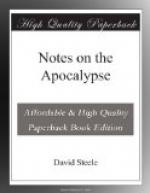Mr. Faber seems to me to give too little prominence in his exposition to Daniel and John’s beast of the sea, as an enemy to Christ. Indeed, he appears to overlook the leading idea involved in the name Antichrist, as a substitutionary, false, and therefore inimical or hostile christ. Instead of keeping before his mind the glorious person of the Mediator as the special object of Antichrist’s enmity, as prophecy requires, he places before him the church or the gospel instead of Christ. Hence he writes thus:—“We find in the predictions of St. John,—(why not St Daniel?) two great enemies of the gospel, Popery and Mohammedism.” Then he adds,—“a third power is introduced,” (Preface, p. 7.) This “third power” he calls “a wilful infidel king,” and, as already noticed, interprets it of “atheistical France.” Now, it will be evident to the intelligent reader that among his “three powers” considered by him as “enemies to the gospel,” he has entirely lost sight of the seven headed ten horned beast, and his hostility to Christ! He has, in fact, manifestly substituted his imaginary “wilful king",—infidel France, for the Roman empire, the beast of Daniel and John, the agent that slays the witnesses, (Rev. xi. 7.) To almost every expositor, and in his lucid moments, even to Mr. Faber himself, it is apparent, that the Roman empire is the primary element in the complex personage that wars against the Lamb. Even kings are but horns of the beast, and Popery but a horn. (Dan. vii. 20; Rev. xvii. 12, 13.)
It is therefore a great mistake on the part of this learned author, to feign an Antichrist distinct from the three confederated enemies of Christ and his witnesses,—enemies so clearly pointed out in prophecy by appropriate and intelligible symbols:—the beast with ten, and the beast with two horns, and the image of the first. These three, all professing the Christian religion, and practically denying it, without the shadow of a doubt, constitute the Antichrist of John, (1 John ii. 19-21.) This is the identical enemy described by Daniel, and according to the inspired predictions of both prophets, doomed to eternal destruction, (Dan. vii. 11; Rev. xix. 20.) Hence it is obvious that Mr. Faber’s “wilful king” is wholly a creature of his own fancy, constituting no feature of the prophetic Antichrist.




